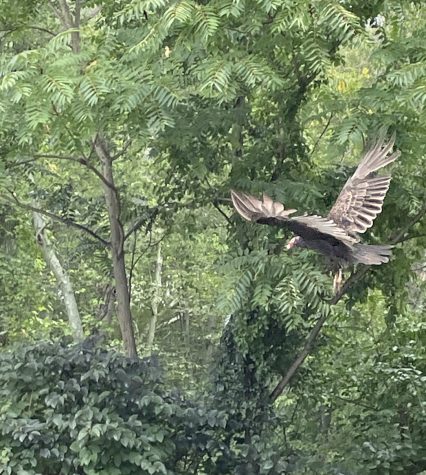Turkeys vs Turkey Vultures: Who NOT to Cook This Thanksgiving
In the spirit of the Thanksgiving season, learn what separates the Turkey from the Turkey Vulture. This article is part of The Wild New Jersey Nature Column!
November 22, 2022
Similar in name but not in really any other way, the Wild Turkey and the Turkey Vulture can be easily identified just by looking at them.
Turkey Vultures are typically seen soaring high in the sky looking for dead animals to scavenge from. They have a huge 6 foot wide wing span, and weigh 2-4 pounds. Despite being commonly mistaken for an eagle or hawk while soaring in the sky, they can’t kill prey since their talons are about as strong as chicken feet. Instead, Turkey Vultures have a very good sense of smell, being able to smell a carcass from their high position in the sky.
Wild Turkeys, on the other wing, are typically seen walking around in groups through the woods or neighborhoods. Males puff up to look large and spherical in shape, with large fanned tails, and red and blue bald faces. Females are smaller and more streamlined shaped, with a duller colored bare face and small tail. Wild Turkeys eat nuts, berries, bugs, and sometimes the occasional lizard, mostly by foraging through the brush. Wild Turkeys can also fly short distances to get to roosting spots or to flee danger, with the capability to fly up to 55 miles per hour. They can also run 18 miles an hour on foot. Wild Turkeys have developed a reputation to be defensive with people getting too close, so it is best to keep your distance from Wild Turkeys, especially when there are baby chicks involved.
Turkey Vultures are very efficient at their job as clean up crew. They are able to digest just about anything in a carcass, from rabies to even some poisons. They are also not afraid to remind you of their unsettling diet–a scared Turkey vulture may puke or defecate in self-defense, and when it gets hot outside they cool their feet by defecating on them. Their bald heads help in staying clean while they eat, serving as an unsettling reminder of what their diet is.
Wild Turkeys can be seen walking around, foraging through forests. However, during fall, male Wild Turkeys can be seen competing with each other for mates, and that often leads to them attacking their reflections on glass or shiny cars. Unlike Turkey Vultures, Wild Turkeys gobble, cluck, and purr instead of screech or hiss.
So what makes them similar? Why are Wild Turkeys often confused with Turkey Vultures? The answer is that they are both bald. Turkey Vultures were named for their bald red head that resembles that of a male Wild Turkey. Other than their lack of hairdo, the two don’t really share much in common.
Cool Facts of Wild Turkeys and Turkey Vultures:
- Turkey Vultures can be seen on tall structures with their wings spread wide in the sun. This is how they heat up their wings to burn off parasites.
- Wild Turkeys are different then Domestic Turkeys (the ones on our tables). Domestic Turkeys are usually white in color and lost the attributes needed to survive in the wild.
- The oldest known Turkey Vulture lived to at least 23 years, while the oldest known Wild Turkey is 13 years.
- Turkey Vultures can be found throughout North and South America (not Canada) and are highly migratory
- Wild Turkeys live exclusively in North America and Northern Mexico, and were not introduced to Europe until after Europeans realized the Americas existed in 1492.
- Native Americans first domesticated Wild Turkeys as far back as 25 A.D.
- In the early 1900s, Wild Turkeys were almost hunted to extinction. Now, their populations are in the millions thanks to conservation efforts.

Sources:
Audubon: http://www.kern.audubon.org/tvfacts.htm
https://www.audubon.org/field-guide/bird/wild-turkey
All About Birds: https://www.allaboutbirds.org/guide/Turkey_Vulture/overview
https://www.allaboutbirds.org/guide/Wild_Turkey/overview
HawkMountain.org: https://www.hawkmountain.org/raptors/turkey-vulture
Biokids: http://www.biokids.umich.edu/critters/Meleagris_gallopavo/
South Carolina Department of Natural Resources: https://www.dnr.sc.gov/news/2020/nov/nov24-wildturkey.php
US Fish and Wildlife: https://www.fws.gov/story/wild-facts-about-wild-turkeys




























